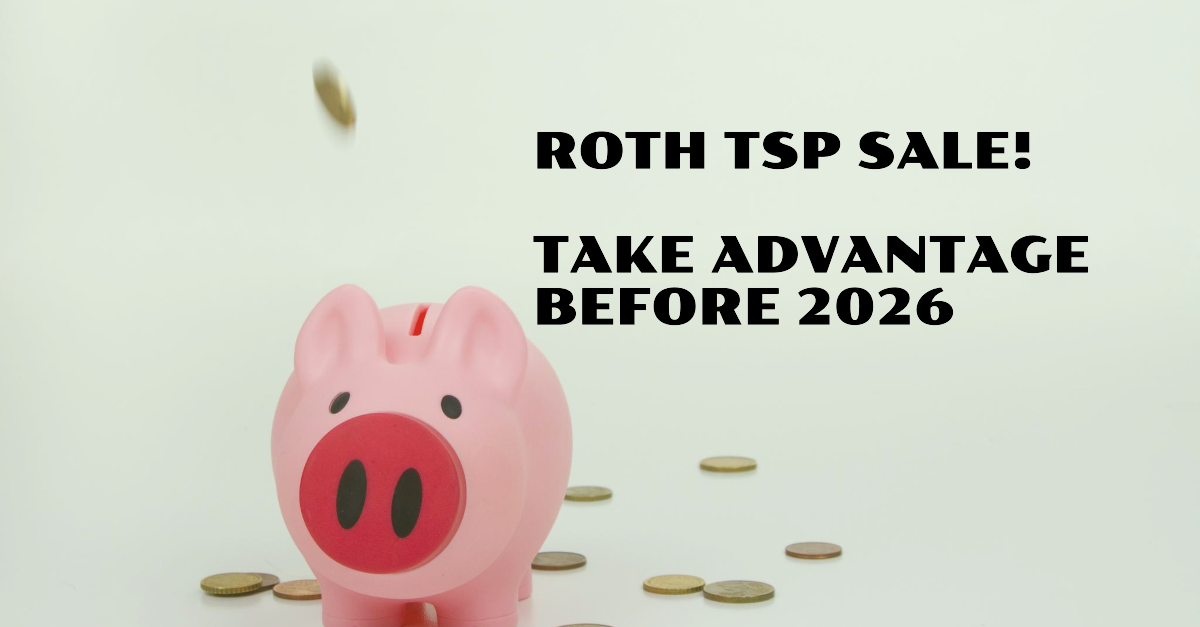Federal employees often consider this when saving for retirement. The great TSP Traditional vs. Roth TSP debate! Should I contribute to the Roth or Traditional TSP? I want to help you understand the difference between Roth versus Traditional TSP, explain the Roth TSP, and review why you should start it today.
What is Roth TSP and How Does It Work for Feds?
Federal employees and members of the uniformed services have one common retirement system, the Thrift Savings Plan. It allows two types of contributions: Traditional or Roth. The difference between them is tax treatment. When you have money in a Roth TSP or Roth IRA, you can withdraw funds at retirement and pay no income tax. All of your contributions and earnings growth are tax-free! However, when you contribute to a Roth TSP, it does not lower your current income tax. This means you’ll pay income taxes upfront, but paying taxes on your contributions today will allow your future earnings to grow tax-free.
The chart below highlights the key differences between Roth TSP and Traditional TSP. Note that contributions go into the TSP using the same investment election. More on this below.
| Thrift Savings Plan Traditional vs Roth | ||
|---|---|---|
| Roth TSP | Traditional TSP | |
| Current Year Contributions |
No Reduction in Taxes |
Reduces Current Taxes |
| Investment Growth |
Tax Deferred | Tax Deferred |
| Withdrawals After Retirement |
Tax-free Withdrawals* |
You'll pay taxes at withdraw |
Investing In Traditional TSP vs Roth TSP
The investment selections between the two accounts are exactly the same. In fact, you cannot invest the accounts any differently. Contributions go in the traditional and Roth TSP exactly the same. You can update your future contributions anytime, but the TSP does not allow you to select different options between the two accounts.
Roth Retirement Account Rules!
There are several important rules regarding Roth accounts that you must follow to receive tax-free distributions.
- You can only withdraw the funds after age 59.5. Or if you retire from federal service after 55.
- If you are a special provision employee (Law Enforcement Officer, Fire Fighter, Air Traffic Controller, etc), you can withdraw from the Roth TSP after retirement
- You have to have the Roth account open for 5 years
- The 5-year rule starts from January 1st of the calendar year you made your first Roth TSP contribution.
So here are some examples to illustrate the 5-year rule:
Josh is a federal employee and started his Roth Thrift Savings Plan when he first started in his 20s. He left federal service in his 40s but left the balance in the TSP. Because he did not retire from federal service, he needs to be 59.5 before he can take distributions as free.
Amy worked 35 years in federal service and retired at her MRA (minimum retirement age). She started her Roth TSP in her 40s. She can immediately take funds from her Roth account, which will be tax-free.
Paul is an LEO with 25 years of service. He retired from federal law enforcement at age 51 and had a Roth account for 10 years. He is eligible to withdraw from Roth TSP immediately.
Diane has 30 years of civilian service and decided to retire at age 62. However, she didn’t start Roth contributions until age 60. Because of the 5 year rule, she must wait until 65 before taking a distribution without paying taxes.
How to Avoid the Roth TSP 5-Year Rule?
If you keep the funds inside the TSP, you cannot avoid it. However, if you have had a Roth IRA for over 5 years and are over age 59.5, you can take the Roth TSP rollover to Roth IRA and circumvent the TSP 5-year Rule.
Roth TSP vs Roth IRAs: Key Differences
Although both accounts have the same tax treatment, there are 2 key differences when comparing Roth IRA vs Roth TSP.
- The Roth IRA has income limitations. You cannot make Roth IRA contributions if your income is too high. The Roth TSP does not have income limitations
- The Roth TSP and Roth IRA have separate 5-year rules. This means that even if you have had a Roth IRA for 5 years, your Roth TSP cannot be tax-free unless its been open for 5 years. The same vice versa.
- A Roth IRA only allows tax-free distributions after the age of 59.5. You cannot take them out earlier.
- Contribution amounts are different between a Roth TSP and a Roth IRA. You can put more in the TSP.
| Roth TSP vs Roth IRA | ||
|---|---|---|
| Roth TSP | Roth IRA | |
| Income Limitations |
No Limitation |
Limited by Income |
| 5 Year Rule |
Yes | Yes |
| Earliest Tax-Free Withdrawal Age |
55 for Regular 50 for Special Provision |
59.5 |
| Maximum Contribution Amounts |
In 2024: Up to $23,000 Plus $7,500 Catch up |
In 2024: Up to $7,000 Plus $1,000 Catch up |
Is TSP Roth Conversions Possible?
Unfortunately, you cannot convert TSP to Roth TSP. At least not directly in the TSP. You can only do that outside the TSP if you want to convert money from your Traditional TSP to Roth. You would move your traditional account to a Traditional IRA. Once that is done, you would convert the Traditional IRA to a Roth IRA. Consider speaking to a financial planner or tax professional before you do it since it may require paying taxes upfront to avoid any penalty.
Roth TSP Contributions: Limits and Matching Contributions From Your Agency
You will still receive matching contributions from the agency, even if you make 100% Roth contributions. However, the matching funds will be added to your traditional account.
The contribution limits for TSP are announced each year by the IRS. For 2024, the contribution limit is $23,000. If you turn 50 or older, you are eligible for catch-up contributions of $7,500. The TSP does a great job of ensuring you do not exceed this limit. However, if you have a second position outside the federal government and have access to a private retirement plan (401k, 403b, etc). It will be up to you to ensure you do not exceed the limits.
In 2026, if your income is above the wage base ($145,000 in 2023), all catch-up contributions will be in the Roth TSP. For more details on why Roth TSP can be especially attractive before 2026, check out our article on Roth TSP contributions on sale until 2026.
Required Minimum Distributions (RMD)
One of the biggest differences between Thrift Savings Plans traditional vs Roth is only the traditional have RMDs. That’s because only pretax retirement assets are subject to withdrawal requirements. The IRS has waited long enough and wants you to start taking funds from traditional retirement savings so you can pay income tax based on the withdrawals. The tax rate will be based on your total income.
Since Roth balance isn’t subject to taxes, Roth TSP or a Roth IRA do not have required minimums. You can learn more about RMDs from our article: Watch Out for the RMD Trap! RMDs Silently Increasing Medicare Premiums in Retirement
Roth TSP vs Traditional TSP: Which TSP is Better?
When you compare Roth vs. Traditional TSP, it is never a clear-cut answer. That is because tax rates in the future are so hard to predict. And because it is unpredictable, having both in your TSP account would be great. Roth and Traditional have advantages and disadvantages, so it is up to you to determine the best time to leverage each. In 2024, current income tax rates and brackets are higher, so making Roth contributions makes sense. However, taxes may increase in 2026, so changing the contribution to traditional might save more tax on your TSP contributions. The same situation applies in retirement; depending on your total retirement income and tax rates, you will need to review your goals and take advantage of the tax benefits available between Roth and Traditional TSP.
Reach Out to Us!
If you have additional federal benefit questions, contact our team of CERTIFIED FINANCIAL PLANNER™ (CFP®), Chartered Federal Employee Benefits Consultants (ChFEBC℠), and Accredited Investment Fiduciary (AIF®). At PlanWell, we are federal employee financial advisors with a focus on retirement planning. Learn more about our process designed for the career fed.
Preparing for federal retirement? Check out our scheduled federal retirement workshops. Sign up for our no-cost federal retirement webinars. Make sure to plan ahead and reserve your seat for our FERS webinar, held every three weeks. Want to have PlanWell host a federal retirement seminar for your agency? Reach out, and we’ll collaborate with HR to arrange an on-site FERS seminar.
Want to fast-track your federal retirement plan? Skip the FERS webinar and start a one-on-one conversation with a ChFEBC today. You can schedule a one-on-one meeting through our Contact page.










